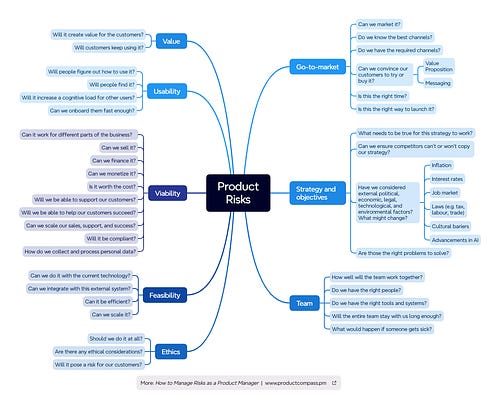Product Management is, at its heart, about managing risk.
But the risks at play are not obvious.
The extended classification beyond the famous "Value, Usability, Viability, and Feasibility:"
—
🚩 1. Ethics: Should we do it at all?
Ethics is sometimes considered part of the Viability risk. Teresa Torres presents it as a separate category. It's so important!
—
🚩 2. Go-to-market: Can we market it? Is it the right way to launch it?
Go-to-market risk is often considered part of Viability risk. But I like presenting it separately, especially for new products.
It’s important to realize that many early experiments test how people will engage with our idea, not whether we can deliver the value promised.
—
🚩 3. Strategic risks: What assumptions need to be true for our strategy to work?
Strategic risks involve your target market, value proposition, competition, and external factors like politics and economics. It's not covered by the experiments performed for the individual features.
—
🚩 4. Objective risks: Are these the right problems to solve?
Objective risks involve setting the right team objectives (e.g., OKRs).
For critical initiatives, one tactic is assigning the same objective to multiple teams in the hope that at least one of them will succeed. For more information, read TRANSFORMED by Marty Cagan.
—
🚩 5. Team risks: How well will the team work together?
Many of those risks can be mitigated with the right leadership. Other risks involve the right teams' topologies.
———
Remember that in product management, you can’t eliminate risks completely. You also can’t ensure that positive risks (opportunities) are realized.
The key to making decisions is being transparent and taking calculated risks informed (not driven!) by data, qualitative insights, and intuition (stemming from experience and immersing yourself in the business and market context).
The ultimate test is users interacting with your product in the real world, using their own data.
What’s critical is to ensure that your teams feel safe to experiment and fail and that when they fail, they can learn from it:
“A good failure is when the value of the lesson is greater than the cost of the lesson. A bad failure is when the value of the lesson is much less than the cost of the lesson.” - Alberto Savoia, author of The Right It
———
Enjoy this?
Learn how to tackle these risks in my guide, "How to Manage Risks as a Product Manager:" productcompass.pm/p/how…
Plus, by subscribing to my newsletter, you can download 30+ free, high-quality product infographics: theproductcompass.tech/…

